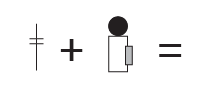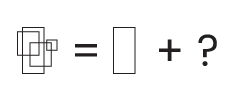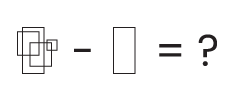Welcome back, shape mixer!
It’s time to combine some shapes with the magical powers of our minds.
The questions we will answer are laid out like an addition sum in maths.
Look at the two shapes below:

Use your magical, shape-moving mind powers to imagine these two shapes combining together.
One, or both of them could rotate, and they are allowed to overlap each other too.
How many different ways can you think of them combining together?
Look at the options below:

Which of these options can be made by combining our two original shapes together?
We need to focus on one of our original shapes at a time and investigate whether it has maintained the same shape, shade and size in our answer options.
It also must have the same line type - this includes the line thickness and line style.
Remember that one or both of the original shapes could also rotate when they combine.
Let’s start with the first shape in our sum.
This shape is made up of a tall, vertical line with two shorter, horizontal lines going through its middle.
Which of our five options show exactly the same shape?
Only options b and d do.
In option a, this shape has an extra line.
In option c, this shape has lost a line.
And, in option e, the line thickness has changed.
Now, we only need to focus on options b and d to see if they contain a match for our second shape.
There’s no point in wasting time looking at the other options when we can eliminate them straight away!
Option b has different shading to the original second shape.
This makes option d our correct answer.
In this option, the first shape has rotated 90° anti-clockwise to combine with the second.
Now it’s time to take your shape-mixing skills to the next level with this new example:

This time, we have been given the combined shape and just one of the separate shapes used to make it.
Our job here is to find the missing shape which joins with the first shape to make the combined shape.
We could treat this as a subtraction question in maths to help us figure out the missing shape.
Just like this:

Which of the following options would join with the single rectangle to make the combined shape?

First, we need to identify what we need to add to the shape on the right (the blank rectangle) to make it look like the combined shape.
Can you see how two medium-sized squares and a small square overlap the blank rectangle?
Which options show two medium-sized squares and a small square?
Options a, b and e do.
This means we can eliminate options c and d straight away.
The line style is different in option e, so this can be eliminated too.
In option a, the small square is in the wrong position.
This leaves us with option b as our correct answer!
It’s now your turn to go on the hunt for combined or missing shapes.
.png) |
Top tip! Remember to check that the new images maintain the same shapes, sizes, shading and line types as the originals. |
Good luck, shape mixer!







